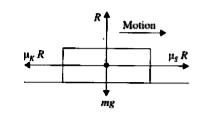When is a body said to be in uniform motion?
To determine when a body is said to be in uniform motion, we can break down the explanation into clear steps:
1. Definition of Uniform Motion:
A body is said to be in uniform motion when it travels equal distances in equal intervals of time.
2. Equal Distances:
This means that if you measure the distance the body travels over a specific time period, that distance remains constant. For example, if a car travels 10 meters every second, it is moving uniformly.
3. Equal Intervals of Time:
The time intervals must also be the same. If the body covers the same distance in each time interval, it confirms that the motion is uniform.
4. Graphical Representation:
The distance versus time graph of a body in uniform motion will be a straight line. This indicates that the distance increases at a constant rate over time.
5. Conclusion:
Therefore, a body is in uniform motion if it covers equal distances in equal time intervals, and this can be visually represented as a straight line on a distance-time graph.
A body is said to be in uniform motion when it travels equal distances in equal intervals of time.
This means that if you measure the distance the body travels over a specific time period, that distance remains constant. For example, if a car travels 10 meters every second, it is moving uniformly.
The time intervals must also be the same. If the body covers the same distance in each time interval, it confirms that the motion is uniform.
The distance versus time graph of a body in uniform motion will be a straight line. This indicates that the distance increases at a constant rate over time.
Therefore, a body is in uniform motion if it covers equal distances in equal time intervals, and this can be visually represented as a straight line on a distance-time graph.
Topper's Solved these Questions
Similar Questions
Knowledge Check
For uniform motion :
Athe distance-time graph is a straight line parallel to the time axis.Bthe speed-time graph is a straight line inclined to the time axis.Cthe speed-time graph is a straight line parallel to the time axis.Dthe acceleration-time graph is a straight line parallel to the time axis.For a body on a horizontal surface, coefficients of static and kinetic frictions are 0.4 and 0.2 respectively. When the body is in uniform motion on the surface, a horizontal force equal in magnitude to limiting friction is applied on it. The acceleration produced is
 A0.4gB0.1 gC0.2 gD0.6 g
A0.4gB0.1 gC0.2 gD0.6 g
A body is said to be in uniform motion if it has uniform velocity.
View SolutionWhen a body is said to be in motion ? What do you mean by motion in one direction ?
View SolutionDraw the x-t graph of an object in uniform motion.
View Solution(A) : Force is required to move a body uniformly along a circle.
(R) : When the body is in uniform circular motion, acceleration is zero.
View SolutionHow do you determine the average speed of a body in non-uniform motion ?
View SolutionWhen is a molecule said to be chiral?
View Solution
